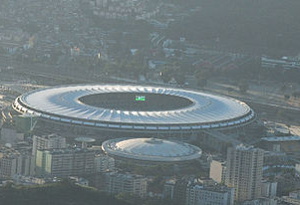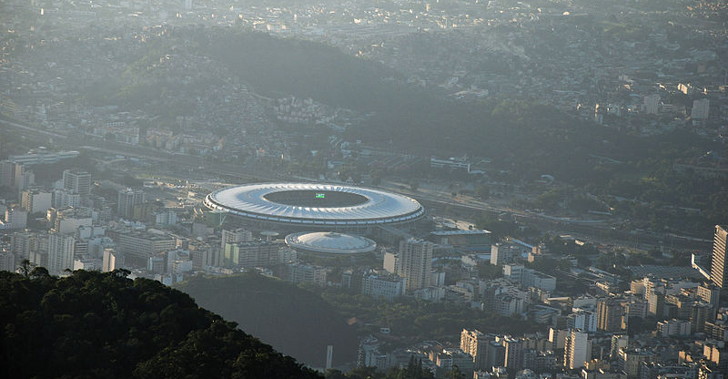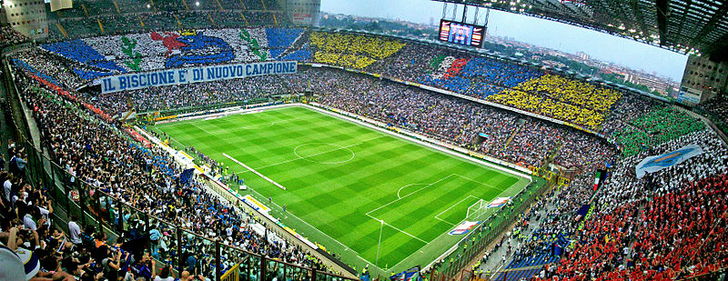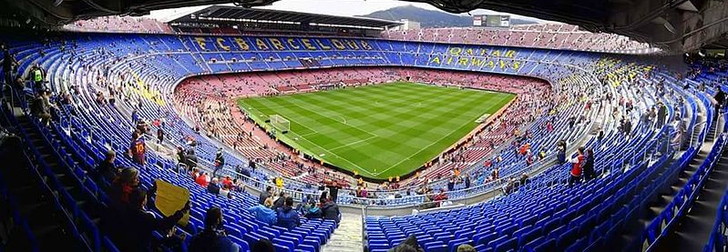
Is it possible to discuss football’s most iconic stadiums without being accused of some sort of bias? Almost certainly not. Fail to put one person’s favourite ground in the list and they’ll be straight onto the complaints form, as though they’re watching Points of View and Anne Robinson will read out their email with an air of faux indignation.
Well, we don’t have a complaints form and this page is filled entirely with our opinions, based on nothing more than how we were feeling when we started writing it.
Somewhat naturally, the iconic stadiums have a distinctly European feel to them. There are certainly some brilliant football grounds in both North and South America, to say nothing of the likes of Japan or Korea. They don’t grab the interest as much as the European ones, however, as the footballing stories that have been passed down from generation to generation tend not to be about an amazing night that took place in the seventies in the Chinese second division.
The list in no particular order and you’re completely free to disagree with us…
Anfield

Supporters of the likes of Manchester United, Everton or Tottenham Hotspur might disagree, but Anfield is arguably the most iconic football stadium in England. Well, it is if you ask a Liverpool fan, anyway.
Nowadays it’s not uncommon for away supporters to sing amusing ditties such as ‘is this a library’, despite the fact that there are clearly no books around and their own grounds are rarely hives of non-stop noise and activity. Yet back in the day the home of Liverpool Football Club was one of the most intimidating places to go in world football. The ground can still be woken up every now and then, with big matches known to cause a rumble that can be heard from nearby Goodison Park.
The famous old line about the Kop, which is the stand where Liverpool’s most vocal supporters tend to position themselves, was that it could suck the ball across the line. More than anything else, Anfield comes alive on a European night. Liverpool supporters are famed for their humour as well as the banners and flags that they take to matches to add to the atmosphere.
Despite changing to an all-seater stadium in the 1990s, the Kop has still enjoyed some brilliant nights including the vanquishing of teams like of Olympiakos, Chelsea and Borussia Dortmund.
Santiago Bernabéu

There’s an extent to which it’s impossible to separate the iconic nature of the Santiago Bernabéu from the exploits of the football club that calls it their home. Real Madrid have won 32 La Liga titles and 11 European Cups, both of which are records in those competitions. Part of their success is due in no small part to how intimidating a place to play football the Bernabéu truly is.
With a capacity of over 80,000, you have to be a mentally strong player to go there and keep your head when a hostile crowd makes you feel like they want to rip you limb from limb.
What makes a stadium iconic isn’t always down to the events that have been held there. Nevertheless, the fact that Real Madrid’s home ground has been used to host four different European Cup Finals as well as the final of a World Cup speaks volumes. As the capital of the country, Madrid is one of the most visited cities in Spain if not Europe. It is filled with countless must-see landmarks, all of which have their own history and reasons to attract interest.
In spite of that, it is the Santiago Bernabéu that you’ll see people streaming towards on a match day, desperate to catch a sight of their heroes.
The Maracanã

We said this article would have a European slant, but it’s impossible to talk of iconic football stadiums and not mention Rio de Janeiro’s Estádio do Maracanã. The ground that stands there now is not exactly the same one that opened in 1950, when it welcomed nearly 200,000 people to watch a group match between Brazil and Uruguay.
It’s still just as impressive as ever, though, and there’s an argument that the modern twists to it – such as how it lights up at night – make it even more worth going to see.
Standing almost in the shadow of the statue of Christ the Redeemer, the Maracanã is where Brazil play their most important matches. The national team tends to rotate through different grounds in Brazil, yet you try telling the residents of Rio that they won’t be watching their side play when the likes of Germany or Argentina come to town.
It’s not a commonly known thing, but the ground’s official name is actually Mário Filho, named in honour of a local journalist, but the nearby Maracanã River is where the title most closely associated with the stadium comes from.
Giuseppe Meazza (San Siro)

To continue the theme of stadiums being known by names other than the one officially given to them, we travel to Italy to talk about the Giuseppe Meazza. Where’s that? You’d probably call it the San Siro.
In fairness, when the ground first opened it was called the Nuovo Stadio Calcistico San Siro, named after the local district it was built in. It didn’t actually get a name change until 1980, when the two clubs who play their games in it agreed to dedicate it the honour of a player who has appeared for both of them.
There are a number of stadiums around the world that host more than one side, something that you can read about here, but the San Siro is almost certainly the best-known of the lot of them. That is likely down to the fact that both Internazionale (often called Inter Milan) and AC Milan (often called simply ‘Milan’) have won eighteen Serie A titles apiece as well as ten European Cups between them.
Having hosted four European Cup finals, perhaps the fact that AC and Inter Milan are such bitter rivals is why the San Siro is so iconic.
Wembley Stadium

It’s difficult to discuss Wembley Stadium without acknowledging that the majority of iconic moments from the ground’s past occurred at a place that no longer exists.
The original Wembley opened in 1923 and hosted some of the England national side and English football’s most famous occasions. The obvious moment that English fans will never stop talking about is when Geoff Hurst struck a ball at the West German goal in the 1966 World Cup final. Though it’s unlikely that the ball fully crossed the line, a goal was given and England went 3-2 up over their fierce rivals. The stadium was knocked down in 2002, taking the famed Wembley Twin Towers with it.
The modern incarnation of the England national team’s home stadium lacks much of the personality of the original, but anyone who spent time in both grounds knows that the new one is a much more pleasant space in which to watch football. The Football Association have done their best to give the new Wembley some iconic things of its own, including a new Wembley Way, an arch to replace the Twin Towers and a statue of England great Bobby Moore.
With a capacity of 90,000 it’s fair to say that the new Wembley’s most iconic moments are yet to occur. Given that it holds the FA Cup semi-finals and final as well as the League Cup final and all of England’s matches, you have to imagine it won’t take long.
Camp Nou

Back to Spain now and to the rivals of Real Madrid, Barcelona. It’s not just on the football pitch where the two Spanish giants go head to head, with both Real and Barca boasting stadiums that are the envy of most of the world.
If the Bernabéu is impressive then Camp Nou is close to being oppressive, such is the overwhelming nature of it as a football ground. It can fit nearly 100,000 people inside its doors and the design of the stadium means that you’ll feel as though you’ve gone back to Roman times and are standing in the centre of a coliseum, ready to take on some lions or gladiators.
The stadium opened its doors for the first time back in 1957, though it has undergone countless renovations and changes since then. It says something for the iconic nature of the ground that Barcelona’s board overwhelmingly rejected the chance to build a new stadium in the mid-2010s, instead choosing to develop the Nou Camp further in order to make it a 105,000 capacity venue.
Even that would be as nothing compared to how it was in the 1980s. When it hosted World Cup matches that year, the capacity was actually over 120,000.
St. James’ Park

There will always and forever be conversations about what makes a stadium iconic. There is no obvious answer to the question, of course. If it was merely about size then Old Trafford would be on this list thanks to its 75,000 plus capacity.
If it was about the success seen there then surely Stamford Bridge would be in with a shout, thanks to Chelsea’s titles, FA Cups and European Cup that they’ve been able to win since Roman Abramovich took over the club and gave them a financial shot in the arm. But iconic means ‘relating to or of the nature of an icon’, and St. James’ Park most certainly ticks that box.
Newcastle supporters haven’t enjoyed a huge amount of success over the years, seeing the club become something of a laughing stock under the ownership of Mike Ashley in recent times. Despite that and their yoyo-like relegation from and promotion back to the top-flight, the club’s supporters remain some of the most loyal in the world.
Football is considered to be like a religion in the land of Geordies, so it shouldn’t be a surprise that the stadium stands on top of a hill and dominates the city like a cathedral. In fact, one side the stadium is slightly lower than the other, meaning that supporters sat in the Leazes End have a brilliant view of both the city and the Tyne.
Signal Iduna Park (Westfalenstadion)

What is a football stadium? What makes one better than another? Surely it is the way the fans feel when they’re there, how they combine to create an atmosphere that pushes the players on to success, often in spite of the odds stacked against them.
With that in mind, it’s difficult not to mention Signal Iduna Park, often known as the Westfalenstadion. Though the ground itself is impressive enough thanks to its location in the middle of a green area of the city of Dortmund (Germany), it is the Südtribüne that truly captures the imagination.
The South Bank of the stadium has room enough for nearly 25,000 people when it is set out for Bundesliga matches, which makes it the biggest standing terrace in Europe.
When the stadium hosts international or European matches it is changed to seating, rather than safe standing, and this reduces the capacity of the entire ground from 81,360 to 65,829. When the stand is full it is known as the ‘Yellow Wall’, with Borussia Dortmund fans wearing yellow and black and waving flags and banners of the same colours. It’s an incredibly impressive sight.
Celtic Park

Last but most certainly not least, Celtic Park is another stadium that boasts a safe-standing section. That has only recently been added to the facilities in the Glasgow-based ground, but it had plenty to recommend it even before then. Supporters of Rangers might well argue that Ibrox deserves to be on this list, but in truth it is their fierce rivals that boast the more iconic football ground.
For starters it has a capacity of just over 60,000, meaning that it’s the largest stadium in Scotland and is larger than all but five of those in the rest of the UK.
In 2014 tests were carried out in stadiums around Europe to find out which ones produced the most noise. Celtic Park was one of two British grounds to make the list, alongside the first one we mentioned – Anfield. Perhaps it’s entirely a coincidence that both sets of supporters sing ‘You’ll Never Walk Alone’ before kick-off, but even if that is the case the two grounds have witnessed some astonishing moments.
In 1967 Celtic made it all the way to the final of the European Cup and went on to win it, boosted along their journey by the incredible noise and colour created by their fans for the home fixtures. An iconic stadium indeed.
